The Civil War doesnt normally fire until the end of the 50's, so you still have some time to go if you are playing as far as the AAR is.
Empire of Liberty - A United States AAR
- Thread starter Spectre48
- Start date
-
We have updated our Community Code of Conduct. Please read through the new rules for the forum that are an integral part of Paradox Interactive’s User Agreement.
You are using an out of date browser. It may not display this or other websites correctly.
You should upgrade or use an alternative browser.
You should upgrade or use an alternative browser.
Wait, you can make Mexico a monarchy? How? I absolutely prefer HM's over Democracies!
Wait, you can make Mexico a monarchy? How? I absolutely prefer HM's over Democracies!
You need Pop Demand Mod.
The Civil War doesnt normally fire until the end of the 50's, so you still have some time to go if you are playing as far as the AAR is.
Yeah, I still have a little bit of time. I haven't had all of the events leading up to the war fire yet, so I'll give it a bit.
If you want the Civil War early, event 16000 be your friend.
Naw I can wait it out. I'm pretty close to having 40% liberal in my upper house, and I'd be able to outlaw slavery on my own. I doubt I'll do that though. The civil war would just be too fun to play.
Update coming later today as well!
Empire of Liberty
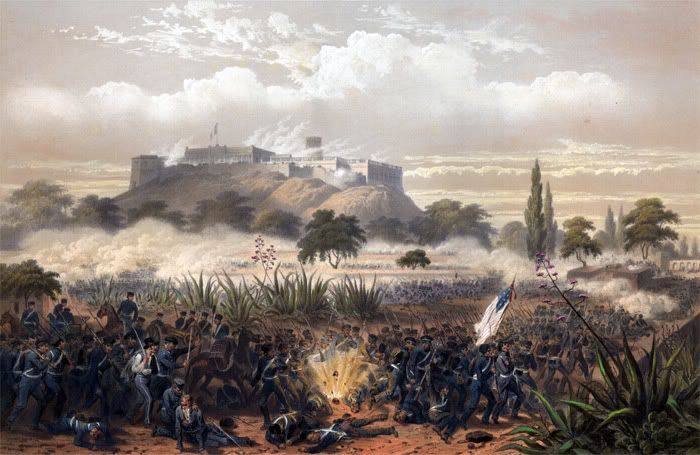
The Mexican Threat
As the United States once again entered election season in early 1848, the population came to find that the politics of the United States was forever changed by the rule of Andrew Jackson. The democratic party was no longer as strong as it had been for the past twenty years, and two new political parties began to gain a small amount of popularity. The first of these was the Socialist Party, and the other was the Populist Party.
The Socialist Party quickly became the main opposition to the Democratic Party, running on the ideals of a pacifist, anti-military state that promotes a government-run economy. Though the Socialists gained some small support within isolated groups of people within the lower-class, they never really gained any true support in the United States due to their secular views.
The Populist Party was a brand new party that was a sort of middle ground between the Socialists and the Democrats. They held the ideals of moralism and pro-military jingoism that the Democratic Party held, yet they also shared some common views with the Socialists. The Populist Party believed that the American Economy should favor American goods, and that foreign goods should be imported only if domestic goods were insufficient. They also believed that with the acquisition of new territory, citizenship should be made easier for other races, and not just whites.
Though these two new parties gained some small support early in the election, the Democratic Party was still far too entrenched in Washington, and when July came, James K. Polk was elected in a landslide to his second term. It wasn't long into his first term, however, that the United States was faced with the loss of another president. James K. Polk died on March 4th, 1849 of natural causes. His vice president, George M. Dallas, took over the presidency the next day.
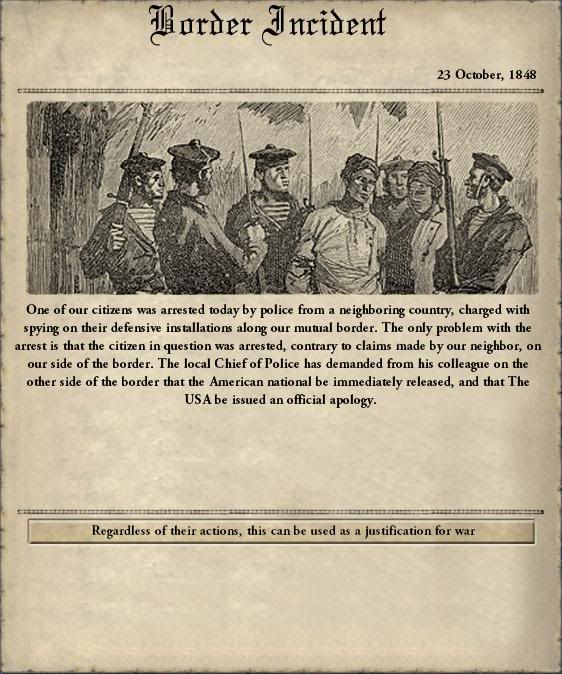
On October 24th 1848, just over 4 months before Polk's death, an American immigrant to southern California was arrested by the Mexican Army on the US side of the border, causing a national uproar. The Polk Administration immediately called for the release of the American citizen. The man was put to trial for spying on the Mexican defensive installations just south of the border - a charge that was disputed by several witnesses. The negotiations were stalled by Mexican authorities for nearly a year until late August, when Mexican authorities judged the man as guilty and he was sentenced to death. The United States issued one last warning to Mexico, and when there was no reply by the 4th of October, 1849, war was declared once again.
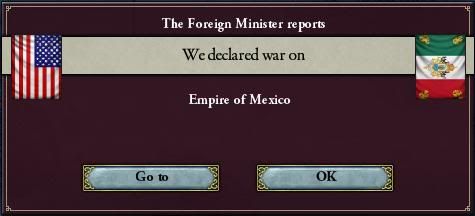
American forces quickly swept into the Mexican states of Sonora and Durango, meeting just as little resistance as in the two prior wars. On October 21st, United States fought their first battle against Mexican forces in three wars at Saltillo, where the American prisoner was being held. A force of 12,000 dragoons rode into the city to find an unprepared garrison of 3,000 Mexicans. The garrison was completely wiped out in two days of fighting, costing the lives of 242 Americans. The prisoner was finally rescued, beaten, battered and starving, and was escorted back to the safety of the United States.
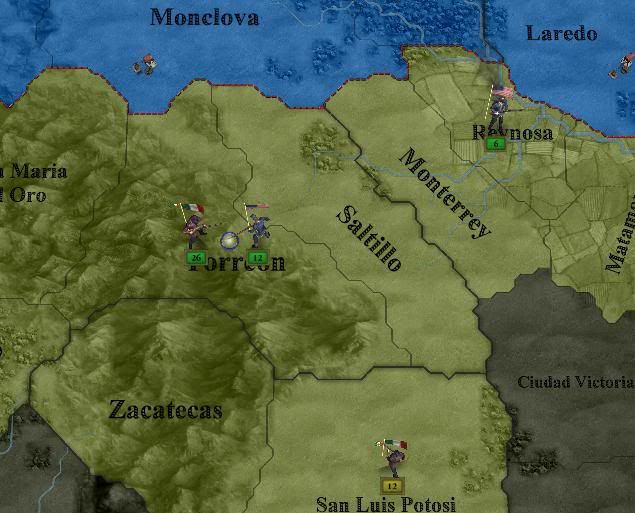
The small force of American cavalry continued on towards the city of Durango, but as they entered the city of Torreon, they received word of a large Mexican force approaching from the South. The US troops quickly prepared for the attack, and on November 16, 1849, the battle began. The US force, numbering nearly 12,000 men, was forced to hold out against 26,000 Mexicans until reinforcements arrived. The battle lasted just a week before the 1st US Army appeared on the horizon, and the Mexican troops were forced to withdraw, suffering a large amount of losses in the process.
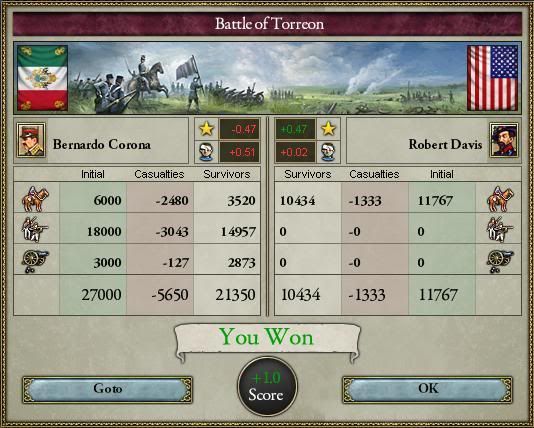
The victory in Torreon left the northern provinces of Mexico open to occupation by American forces. By mid-1850, the entire states of Sonora and Durango were occupied, and the US forces once again threatened to push south into Mexico city. On July 27, 1850, Emperor Santa Anna agreed to cede the Mexican province of Sonora to the United states as an addition to the buffer between the US and Mexico. It was clear that his army was still in no shape to fight the more organized US forces.
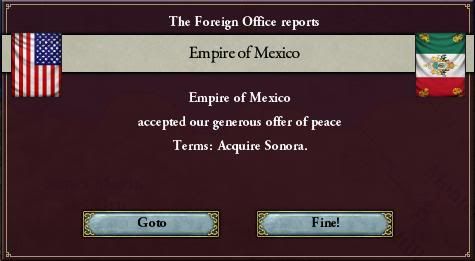
As the United States settled once again into peacetime activities, the continent of Europe exploded into war. On May 1st of 1851, the German state of Prussia and her southern ally, Austria-Hungary, were declared war upon by the Franco-Russian alliance for a slice of eastern Prussia known as the Rhineland. For the first few months of the war, Prussia and Austria-Hungary decided upon an invasion of Russia, to crush the Russians and remove them from the war before the French and Dutch could negotiate military passage through the neutral German States in the west.
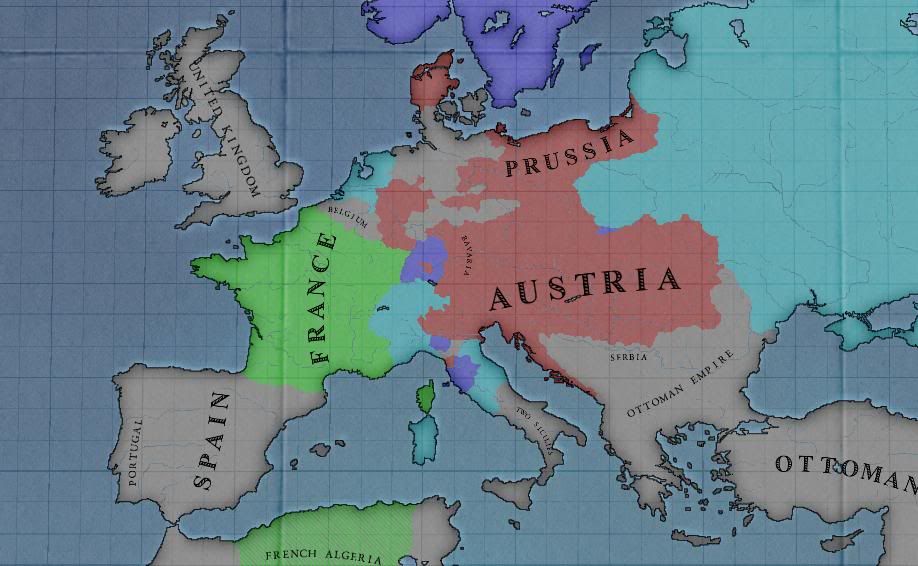
This strategy worked well at first, and by late August, Russia was ready to discuss peace with the Prussians. As Germany turned their attention to the west, however, the neutral German states disapproved Prussian forces from entering their lands, just as they refused France and the Netherlands. Prussia was outraged by this, and had no choice but to surrender the Rhine to the French or risk an extremely costly naval invasion.
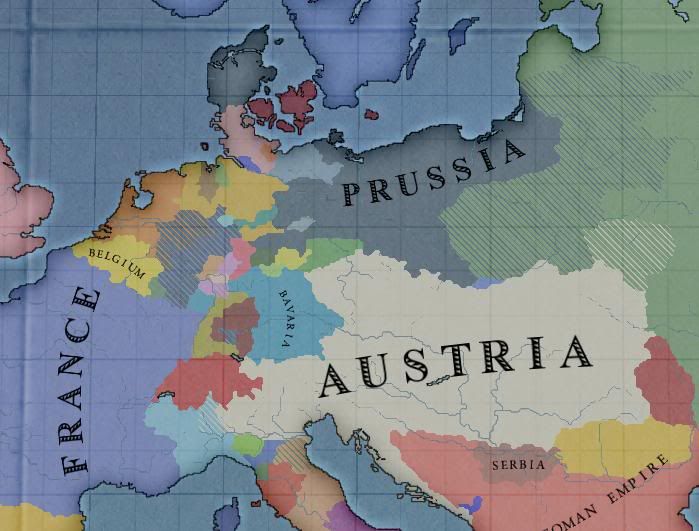
The war in Europe just before the Russian surrender.
With the Prussians bitterly accepting the defeat, they turned to their German neighbors. The western Germans had forced Prussia into surrendering the Rhineland and leave the war against France, which also would come to cost them their alliance with Austria-Hungary. As the war came to an end and Prussia began strong-arming the German states, Kaiser Frederick William IV of Prussia saw the need for a new ally. The Kaiser found this ally in the United States, and in July of 1852, the two powers became allies, and two months later, the German states were united and the Northern German Confederation was born.
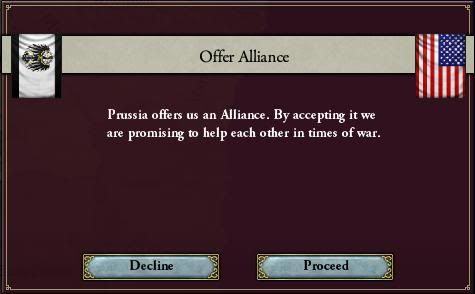
After the unification, Kaiser Frederick William IV of Germany was eager to find a strong ally, as the rest of Europe continued to view Germany as a threat. Prussia and the United States had long had a good relationship, and it was in the United States that the Kaiser found this ally. In June of 1852, the two powers became allies. The alliance with the powerful European nation sealed an already likely reelection for George M. Dallas, and he began his second term the next month.
In addition to signing the alliance with Germany, President Dallas also looked to expand American interests in Asia, and began supporting pro-American governments in Dai Nam and China. By the middle of 1853, the United States' sphere of influence extended over a great amount of Asia, and America's Empire was beginning to rival that of Great Britain.
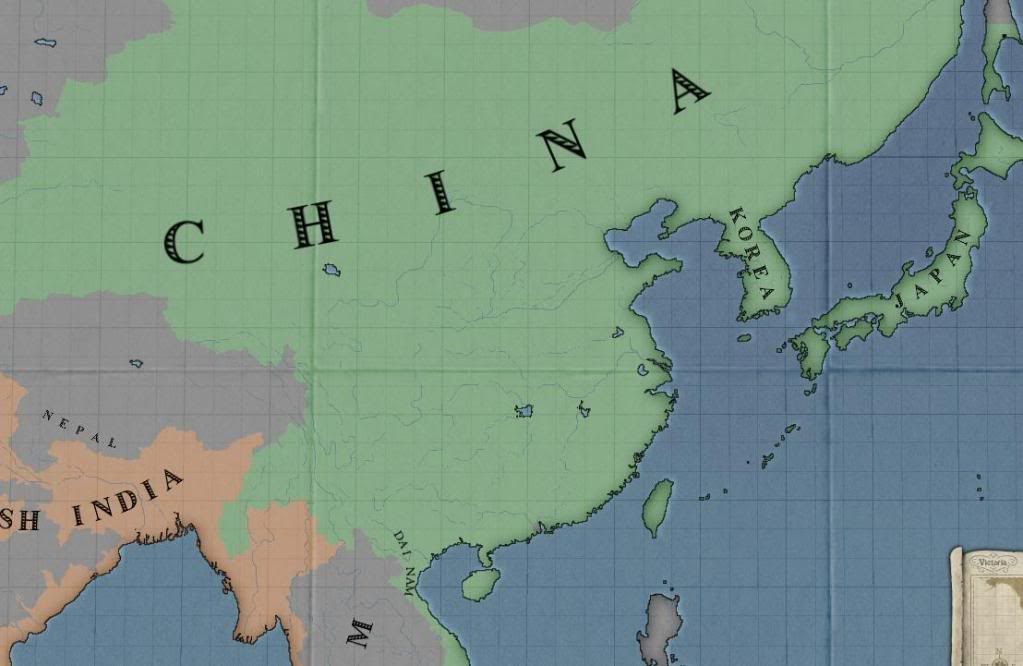
Throughout the early 1850's, the United States enjoyed quick economic and military growth. President Dallas continued the building of the new, modern navy that James K. Polk had begun, and continued the growth of the US Army. In October of 1854, this looked like it would soon pay off. A large group of Mexican democrats in northern Mexico rose up in arms against their Imperial lords, and attempted to secede from the Mexican Empire. While the revolt was easily crushed, the idea spread like wildfire, and soon democratic revolts were spreading throughout northern Mexico. Within two months, the revolts were crushed, and hundreds of Mexican democrats moved north across the border into the United States to escape the slaughter.

By July of 1855, tens of thousands of men and women were murdered for speaking out against the Mexican government, and the United States, head by President Dallas, was not about to sit by and watch. War was declared on Mexico on August 16th, 1855, and the Mexican-American Wars continued.
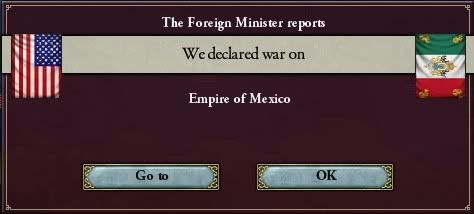
In early September, the 1st US Army began a push into northern Mexico and were met quickly by the reorganized, more prepared Mexican army. The Battle of Northern Mexico began on November 7th, 1855 when the Mexican and American forces met just outside of Reynosa, Mexico. In just over a week, there were 24,000 deaths, but the United States had forced the Mexican retreat. The two sides met again in Monterrey, where another 24,000 casualties were sustained and again Mexican forces retreated. The battle continued until January 18th, 1856, when the US forces finally took the remaining Mexican soldiers prisoner in Ciudad Victoria, and the Mexican Army was destroyed.
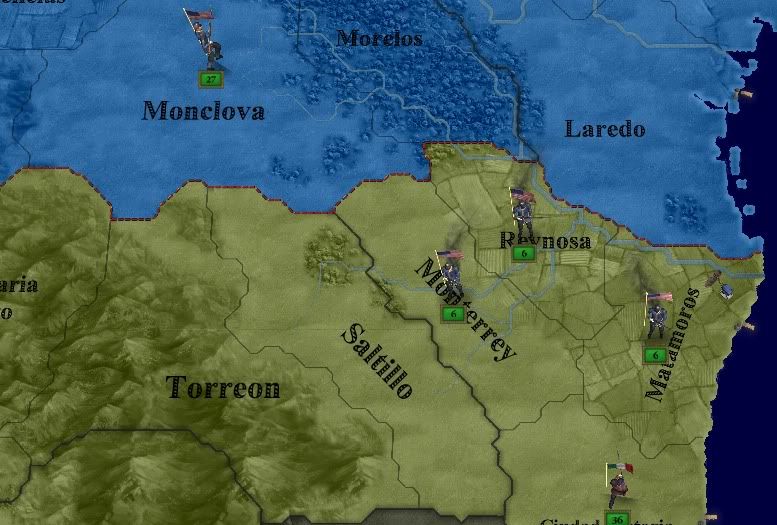
American forces invading Nuevo Leon, just before regrouping in Reynosa to face the Mexican forces.
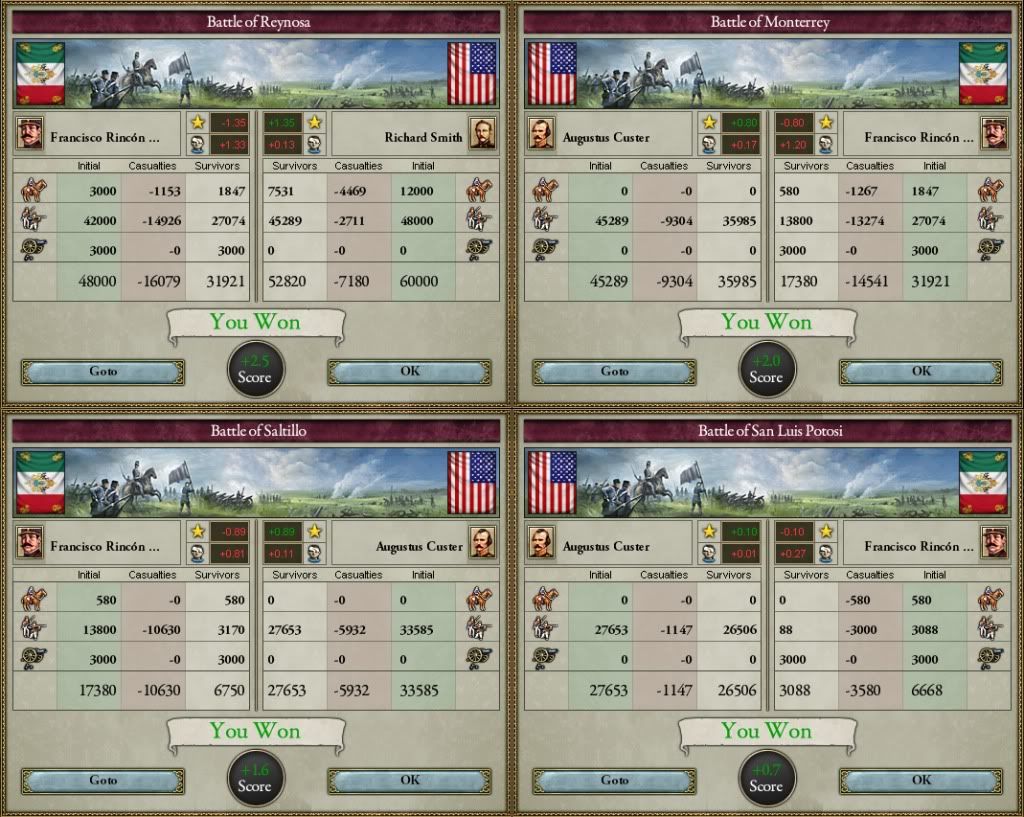
In celebration of this great victory against the imperialists in Mexico and the liberation of the Californian territories, Germany presented a gift to the United States: The Statue of Liberty. The statue took just over ten years to build, but with the new war raging between Mexico and the United States and the victory in the Battle of Mexico, the timing was perfect for the completion and presentation to Germany's new ally. The Statue was set in New York Harbor on the 17th of June, 1856.
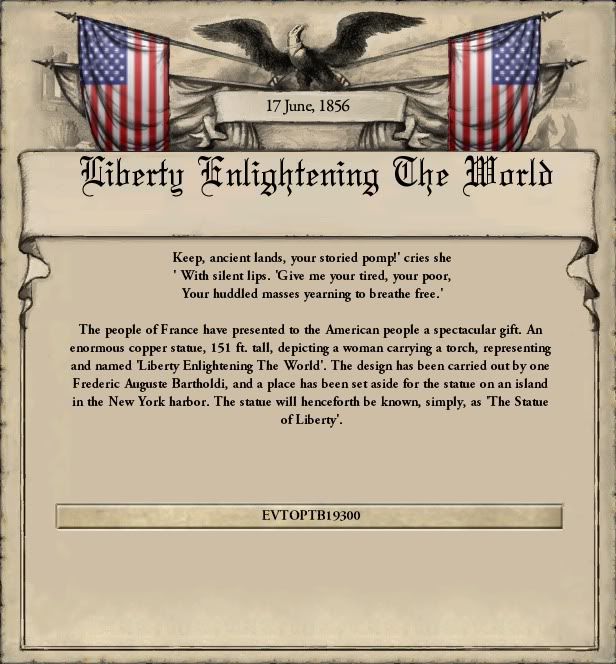
The next month, the United States decided to elect James Buchanan as the 10th president of the United States, as George Dallas decided not to run again, and to quietly retire. Buchanan, an expansionist and pro-American leader, was backed by both the Democratic and the Populist parties and won with 99.87% of the vote and promised to end the Mexican threat and the Mexican government's murder of their own people.
With the Mexican army crushed, the United States quickly swept south into the heart of the Mexican Empire. Mexico City was occupied in mid-June of 1856 and Emperor Santa Anna once again looked for a negotiation with the United States. President Buchanan, however, was not easily swayed, and would not end the war unless Santa Anna either resigned, or ceded the northern provinces that revolted against him. As an additional condition, if Mexico was to continue the massacres of her own people, the United States would have the right to once again intervene and remove Santa Anna from power. The Mexican Emperor had no choice but to accept.
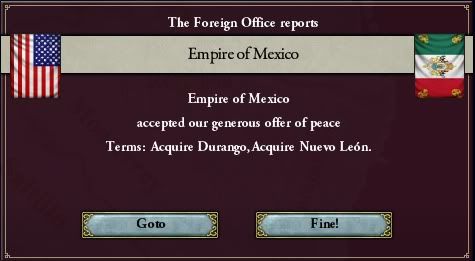
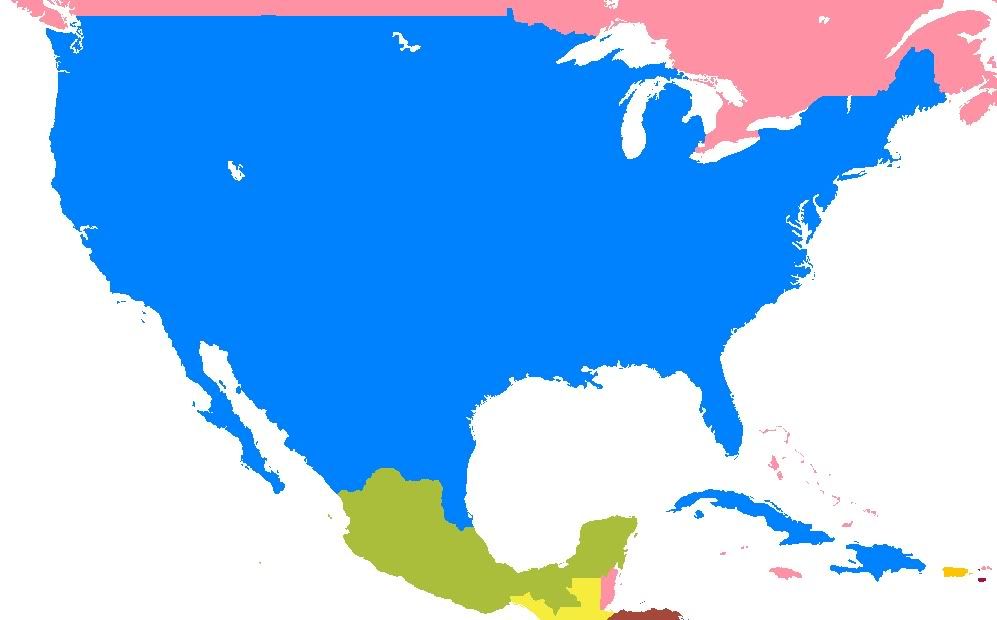
The United States after the acquisition of Durango and Nuevo Leon.
President Buchanan enjoyed peace throughout most of this first term, but once again the slavery debate took stage and began threatening to split the Union in half. The Buchanan administration would be tested, pushed to the limit and forced to choose to back the north or the south. The wrong choice at the wrong time could mean the bloodiest war in American history.

The Mexican Threat
As the United States once again entered election season in early 1848, the population came to find that the politics of the United States was forever changed by the rule of Andrew Jackson. The democratic party was no longer as strong as it had been for the past twenty years, and two new political parties began to gain a small amount of popularity. The first of these was the Socialist Party, and the other was the Populist Party.
The Socialist Party quickly became the main opposition to the Democratic Party, running on the ideals of a pacifist, anti-military state that promotes a government-run economy. Though the Socialists gained some small support within isolated groups of people within the lower-class, they never really gained any true support in the United States due to their secular views.
The Populist Party was a brand new party that was a sort of middle ground between the Socialists and the Democrats. They held the ideals of moralism and pro-military jingoism that the Democratic Party held, yet they also shared some common views with the Socialists. The Populist Party believed that the American Economy should favor American goods, and that foreign goods should be imported only if domestic goods were insufficient. They also believed that with the acquisition of new territory, citizenship should be made easier for other races, and not just whites.
Though these two new parties gained some small support early in the election, the Democratic Party was still far too entrenched in Washington, and when July came, James K. Polk was elected in a landslide to his second term. It wasn't long into his first term, however, that the United States was faced with the loss of another president. James K. Polk died on March 4th, 1849 of natural causes. His vice president, George M. Dallas, took over the presidency the next day.

On October 24th 1848, just over 4 months before Polk's death, an American immigrant to southern California was arrested by the Mexican Army on the US side of the border, causing a national uproar. The Polk Administration immediately called for the release of the American citizen. The man was put to trial for spying on the Mexican defensive installations just south of the border - a charge that was disputed by several witnesses. The negotiations were stalled by Mexican authorities for nearly a year until late August, when Mexican authorities judged the man as guilty and he was sentenced to death. The United States issued one last warning to Mexico, and when there was no reply by the 4th of October, 1849, war was declared once again.

American forces quickly swept into the Mexican states of Sonora and Durango, meeting just as little resistance as in the two prior wars. On October 21st, United States fought their first battle against Mexican forces in three wars at Saltillo, where the American prisoner was being held. A force of 12,000 dragoons rode into the city to find an unprepared garrison of 3,000 Mexicans. The garrison was completely wiped out in two days of fighting, costing the lives of 242 Americans. The prisoner was finally rescued, beaten, battered and starving, and was escorted back to the safety of the United States.

The small force of American cavalry continued on towards the city of Durango, but as they entered the city of Torreon, they received word of a large Mexican force approaching from the South. The US troops quickly prepared for the attack, and on November 16, 1849, the battle began. The US force, numbering nearly 12,000 men, was forced to hold out against 26,000 Mexicans until reinforcements arrived. The battle lasted just a week before the 1st US Army appeared on the horizon, and the Mexican troops were forced to withdraw, suffering a large amount of losses in the process.

The victory in Torreon left the northern provinces of Mexico open to occupation by American forces. By mid-1850, the entire states of Sonora and Durango were occupied, and the US forces once again threatened to push south into Mexico city. On July 27, 1850, Emperor Santa Anna agreed to cede the Mexican province of Sonora to the United states as an addition to the buffer between the US and Mexico. It was clear that his army was still in no shape to fight the more organized US forces.

As the United States settled once again into peacetime activities, the continent of Europe exploded into war. On May 1st of 1851, the German state of Prussia and her southern ally, Austria-Hungary, were declared war upon by the Franco-Russian alliance for a slice of eastern Prussia known as the Rhineland. For the first few months of the war, Prussia and Austria-Hungary decided upon an invasion of Russia, to crush the Russians and remove them from the war before the French and Dutch could negotiate military passage through the neutral German States in the west.

This strategy worked well at first, and by late August, Russia was ready to discuss peace with the Prussians. As Germany turned their attention to the west, however, the neutral German states disapproved Prussian forces from entering their lands, just as they refused France and the Netherlands. Prussia was outraged by this, and had no choice but to surrender the Rhine to the French or risk an extremely costly naval invasion.

The war in Europe just before the Russian surrender.
With the Prussians bitterly accepting the defeat, they turned to their German neighbors. The western Germans had forced Prussia into surrendering the Rhineland and leave the war against France, which also would come to cost them their alliance with Austria-Hungary. As the war came to an end and Prussia began strong-arming the German states, Kaiser Frederick William IV of Prussia saw the need for a new ally. The Kaiser found this ally in the United States, and in July of 1852, the two powers became allies, and two months later, the German states were united and the Northern German Confederation was born.

After the unification, Kaiser Frederick William IV of Germany was eager to find a strong ally, as the rest of Europe continued to view Germany as a threat. Prussia and the United States had long had a good relationship, and it was in the United States that the Kaiser found this ally. In June of 1852, the two powers became allies. The alliance with the powerful European nation sealed an already likely reelection for George M. Dallas, and he began his second term the next month.
In addition to signing the alliance with Germany, President Dallas also looked to expand American interests in Asia, and began supporting pro-American governments in Dai Nam and China. By the middle of 1853, the United States' sphere of influence extended over a great amount of Asia, and America's Empire was beginning to rival that of Great Britain.

Throughout the early 1850's, the United States enjoyed quick economic and military growth. President Dallas continued the building of the new, modern navy that James K. Polk had begun, and continued the growth of the US Army. In October of 1854, this looked like it would soon pay off. A large group of Mexican democrats in northern Mexico rose up in arms against their Imperial lords, and attempted to secede from the Mexican Empire. While the revolt was easily crushed, the idea spread like wildfire, and soon democratic revolts were spreading throughout northern Mexico. Within two months, the revolts were crushed, and hundreds of Mexican democrats moved north across the border into the United States to escape the slaughter.

By July of 1855, tens of thousands of men and women were murdered for speaking out against the Mexican government, and the United States, head by President Dallas, was not about to sit by and watch. War was declared on Mexico on August 16th, 1855, and the Mexican-American Wars continued.

In early September, the 1st US Army began a push into northern Mexico and were met quickly by the reorganized, more prepared Mexican army. The Battle of Northern Mexico began on November 7th, 1855 when the Mexican and American forces met just outside of Reynosa, Mexico. In just over a week, there were 24,000 deaths, but the United States had forced the Mexican retreat. The two sides met again in Monterrey, where another 24,000 casualties were sustained and again Mexican forces retreated. The battle continued until January 18th, 1856, when the US forces finally took the remaining Mexican soldiers prisoner in Ciudad Victoria, and the Mexican Army was destroyed.

American forces invading Nuevo Leon, just before regrouping in Reynosa to face the Mexican forces.

In celebration of this great victory against the imperialists in Mexico and the liberation of the Californian territories, Germany presented a gift to the United States: The Statue of Liberty. The statue took just over ten years to build, but with the new war raging between Mexico and the United States and the victory in the Battle of Mexico, the timing was perfect for the completion and presentation to Germany's new ally. The Statue was set in New York Harbor on the 17th of June, 1856.

The next month, the United States decided to elect James Buchanan as the 10th president of the United States, as George Dallas decided not to run again, and to quietly retire. Buchanan, an expansionist and pro-American leader, was backed by both the Democratic and the Populist parties and won with 99.87% of the vote and promised to end the Mexican threat and the Mexican government's murder of their own people.
With the Mexican army crushed, the United States quickly swept south into the heart of the Mexican Empire. Mexico City was occupied in mid-June of 1856 and Emperor Santa Anna once again looked for a negotiation with the United States. President Buchanan, however, was not easily swayed, and would not end the war unless Santa Anna either resigned, or ceded the northern provinces that revolted against him. As an additional condition, if Mexico was to continue the massacres of her own people, the United States would have the right to once again intervene and remove Santa Anna from power. The Mexican Emperor had no choice but to accept.


The United States after the acquisition of Durango and Nuevo Leon.
President Buchanan enjoyed peace throughout most of this first term, but once again the slavery debate took stage and began threatening to split the Union in half. The Buchanan administration would be tested, pushed to the limit and forced to choose to back the north or the south. The wrong choice at the wrong time could mean the bloodiest war in American history.
Such a beautiful map of North America. Though the Civil War should be easy enough with all these new free states from Mexico
I liked the "German Statue of Liberty" spin. France can suck USA's imperialist nads. 
After you lay waste to Mexico... next stop... taking territory away from China! (Concessions?)
After you lay waste to Mexico... next stop... taking territory away from China! (Concessions?)
China's already in his sphere, so he can't attack them, and anyway why would you? The massive market China provides and all that cannon fodder are reason enough to keep them as allies. Though I would love seeing you go a-conquering down in SA, I'd love to see America own everything coast to coast (and by that I mean from the Arctic to the Southern coasts, lol).
Such a beautiful map of North America. Though the Civil War should be easy enough with all these new free states from Mexico
I don't want to make it too easy. I'm refraining from recruiting any foreign troops at the moment, forcing me to recruit from the south even if I know it means a chance of them siding with the Confederates.
I liked the "German Statue of Liberty" spin. France can suck USA's imperialist nads.
After you lay waste to Mexico... next stop... taking territory away from China! (Concessions?)
China's already in his sphere, so he can't attack them, and anyway why would you? The massive market China provides and all that cannon fodder are reason enough to keep them as allies. Though I would love seeing you go a-conquering down in SA, I'd love to see America own everything coast to coast (and by that I mean from the Arctic to the Southern coasts, lol).
Chinese concessions aren't completely out of the question, but it's not very high on my list. I do have some good stuff for my next update though, coming soon to a forum page near you! I should have her ready in a couple of days.
Last edited:
Empire of Liberty
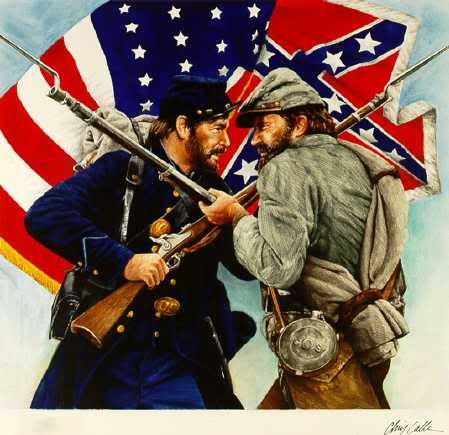
A House Divided
The United States thrived throughout the remainder of the 1850's. The economy was growing quickly, and had become one of the strongest in the world under the Buchanan administration. The US military also enjoyed rapid growth - especially the navy. The size of the US Atlantic fleet had tripled during the presidency of Buchanan, and was now finally able to defend the shores of America against potential blockades.
While the American navy was still no match for the British Navy, it did threaten the French and the Spanish. Tensions rose quickly between the Americans and the Franco-Spanish alliance, and in February of 1859, these tensions reached a peak when an American ship on shore leave was mysteriously destroyed. The ship, the USS Washington, was on leave on the Spanish island of Puerto Rico. President Buchanan was quick to point fingers, and within weeks the United States was once again calling for Spanish blood.
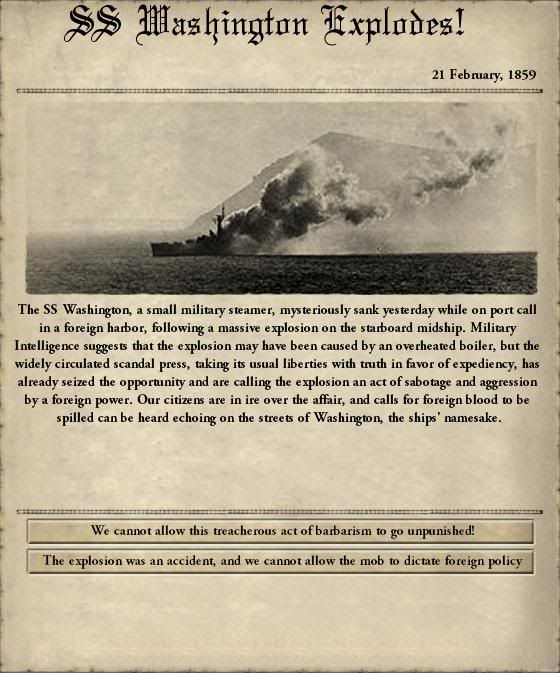
While Spain never directly took responsibility for the attacks on the USS Washington, they never denied that they were behind the attack. On July 18th, 1849, the United States demanded that the Spanish pay for the lost ship and issue a public apology. The Spanish immediately refused the demand, and three days later, on July 21st, the Second Spanish-American war began with the United States' declaration of war on Spain. France, seeing the war as a chance to cripple the US navy, decided to defend her ally and declared war on the United States the next day.
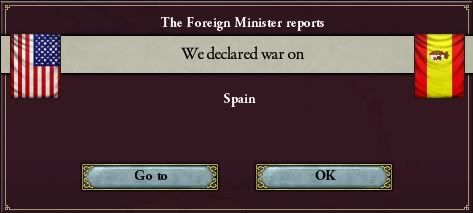
The war between the United States and the Franco-Spanish alliance went on for six months without any conflict, either on land or at sea. As January brought a new decade upon America, presidential elections began. For the first two months, James Buchanan seemed to be the dominant political figure in the United States. His only real opponent, the National Populist Party candidate, Abraham Lincoln, held some popularity in the north, but had none of the southern, pro-slavery vote.
Everything changed on March 22nd, 1860, however, when the Supreme Court made a ruling on the Dred Scott v Sandford case. The Supreme Court stated that African-Americans brought into the United States as slaves were not protected by the Constitution and could never be U.S. citizens. This shattered the north's opinion of both Buchanan and the Democratic Party. The northern states saw this as an effort to implement slavery throughout the Union, and support quickly built for Abraham Lincoln and the National Populist Party. Abraham Lincoln promised an end to the slavery debate, gaining him the vast majority of the northern vote, but costing him the southern vote. Irregardless, Abraham Lincoln was elected president with 69% of the popular vote, and the democrats were defeated for the first time in 31 years.
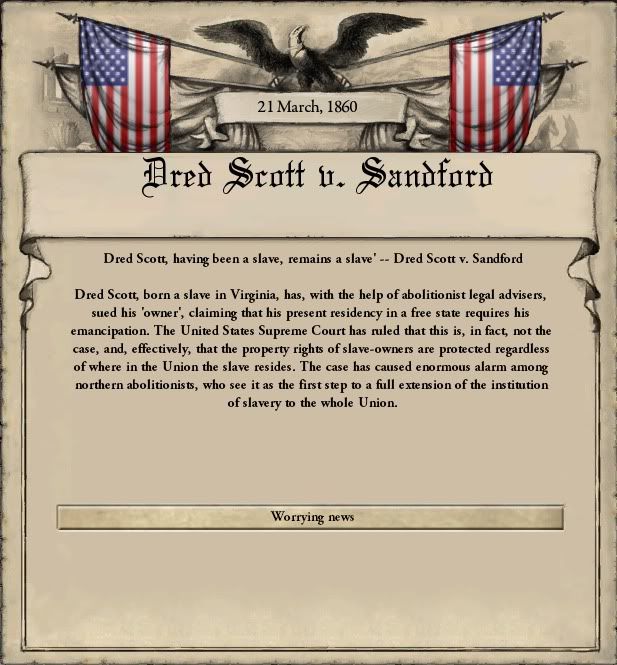
This stalemate between the Franco-Spanish alliance and the United States lasted until early April of 1860, when the French navy made a move to blockade the eastern US coast. In response to the blockade, the United States landed troops in major allied islands in the Caribbean. By the end of the month, Puerto Rico, Guadeloupe and Martinique were in American hands, and the US finally decided to test her new fleet.
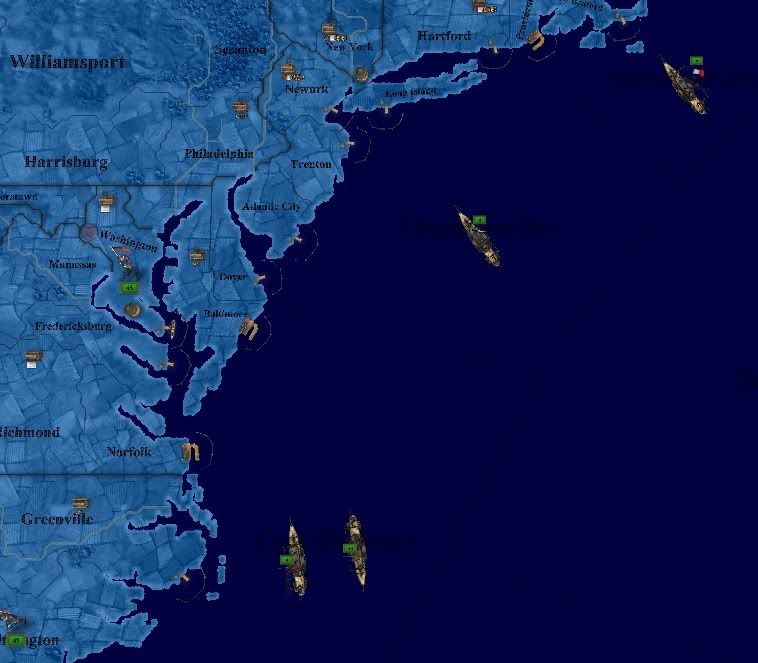
The French blockade of the United States

US occupation of the Franco-Spanish Caribbean
The first naval battle between France and the United States began on April 29th, and lasted until May 6th. The United States' Atlantic Fleet of 35 commerce raiders launched an attack on 4 French commerce raiders. The US fleet was victorious, and quickly sailed down to the Florida Straits, where they met a larger French fleet of 8 commerce raiders. The French were once again annihilated, and the Atlantic Fleet made her way to the Lesser Antilles to face a third French fleet. Over the three battles, 12 French commerce raiders were destroyed, and the United States didn't suffer a single loss. The French blockade was broken by a superior US Navy.
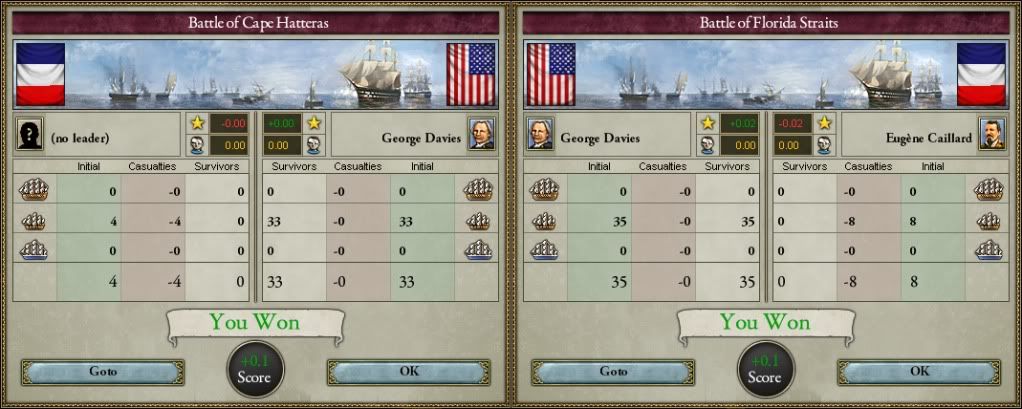
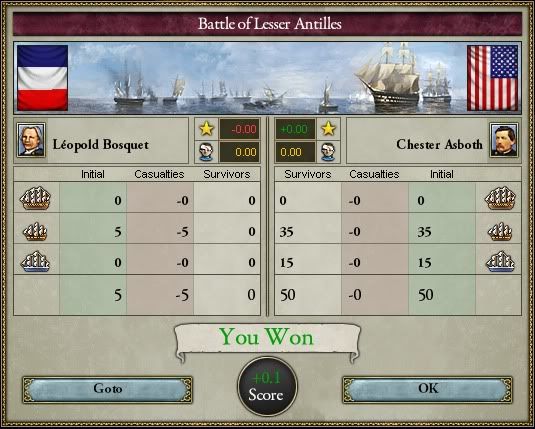
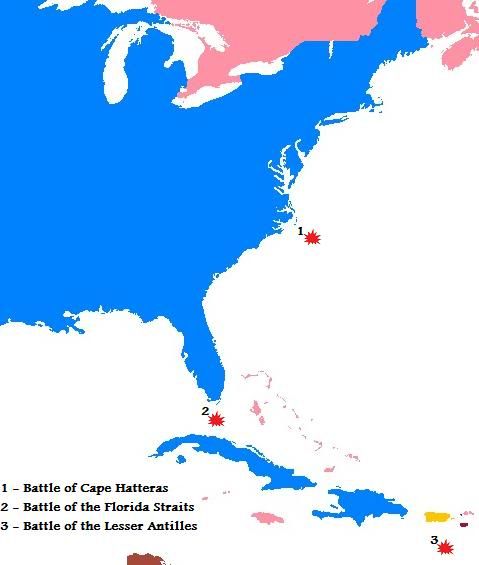
France quickly gave up the naval war against the United States, and demanded an attack from her ally, Spain. The Spanish quickly drew up plans for an invasion of Haiti, with the US coast now well protected by the navy. The invasion didn't come until October of 1860, when 26,500 Spanish troops landed in Cap Haitian. The United States quickly responded by sending the 1st US Army to La Vega to cut off the Spanish advance.
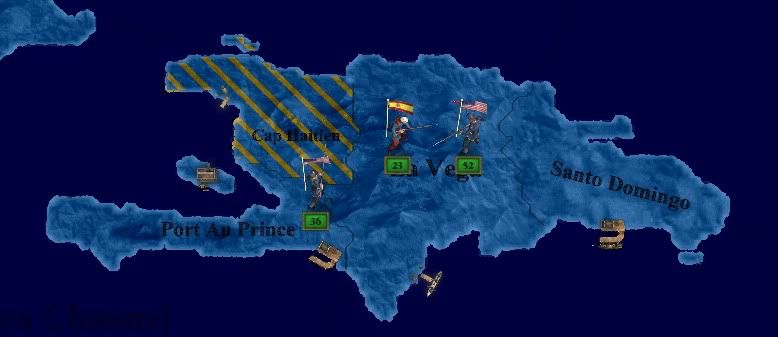
On November 3rd, 1860, the two forces met. The battle was extremely one sided, with the demoralized Spanish fighting the well fed, well rested American forces. The battle lasted just a week until the Spanish army was defeated. 506 Americans died in La Vega, but the entire Spanish army was wiped out, and the Franco-Spanish alliance was defeated. The next day, on November 11th, a ceasefire was declared, and Spain ceded the remainder of her American territories to the United States.
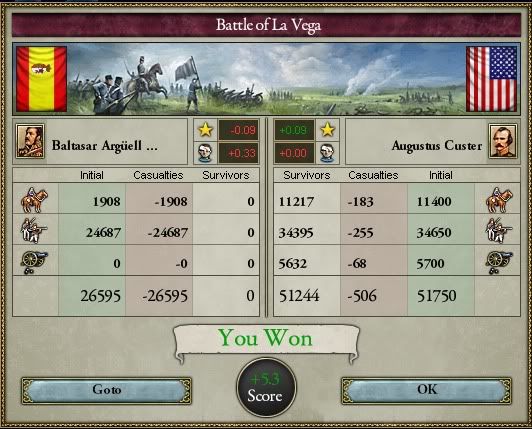
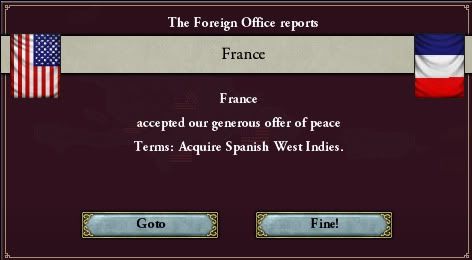
The Americans were just as eager to make peace as the French and Spanish were, however, and there was little celebration of the victory. On January 1st, a northern abolitionist named John Brown was hanged in the state of Virginia after a failed raid on a military armory. The goal was to arm slaves to fight against the slaveholders of the south, escalating southern tension over slavery. There was open talk by southern states of secession from the Union, and the US government struggled to keep the south in line.
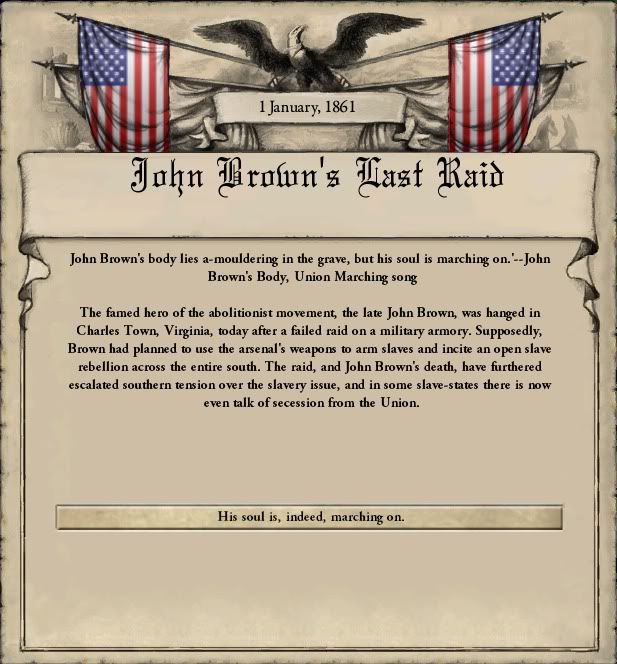
President Lincoln did an admirable job to appease the south, but despite his efforts, many southern states seceded over late January and early February. The US desperately attempted to hold on to these states, but on January 10th, 1861, the states formed their own government - the Confederate States of America. Tensions between north and south - Union and Confederacy - rose to a boiling point. The Union declared the secession of the south as illegal and unconstitutional, but the Confederacy stood her ground. Neither side was willing to make the first move in the Civil War, but it was the Confederacy who would begin the war by the assault on Union-held Fort Sumter on February 14, 1861.
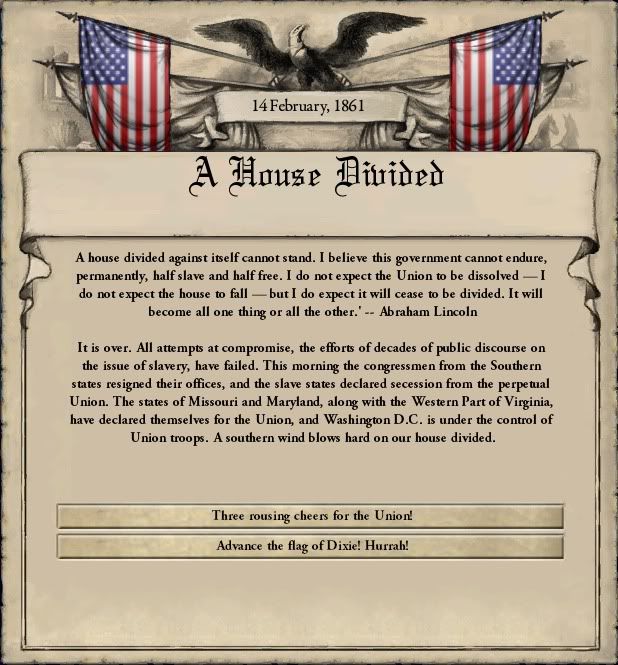
Overall, 10 states seceded from the Union - Virginia, North Carolina, South Carolina, Louisiana, Mississippi, Alabama, Georgia, Florida and Cuba. The western half of Virginia was not willing to secede, however, and the territory of Western Virginia declined to join the Confederate States.
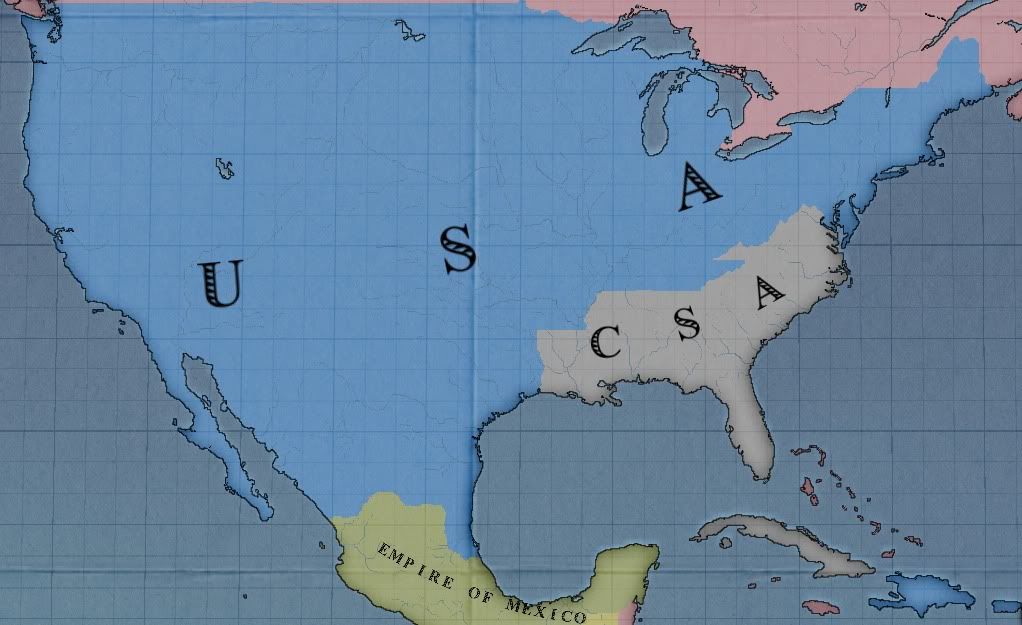
The first two major battles of the American Civil War occurred as the Union forces invaded the South through Louisiana and the Confederate forces invaded the North in an attempt to capture Washington. The first Battle for Washington began just 12 days after the Civil War began, and resulted in 5,000 Confederate losses. It was a decisive Union victory, and thwarted the early Confederate attempt to seize the Union capital.
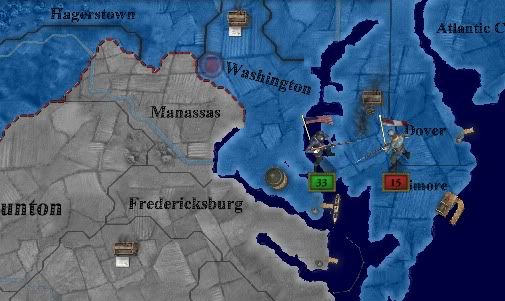
With the Confederate defeat in Maryland, the Union decided to begin their own invasion, sending an army of 40,000 east from Texas into Louisiana. At the Battle of Shreveport, the Union forces met a smaller Confederate force of 12,000. The battle lasted just under a week, and on March 30th, the Confederate troops began retreating deeper into New Orleans.
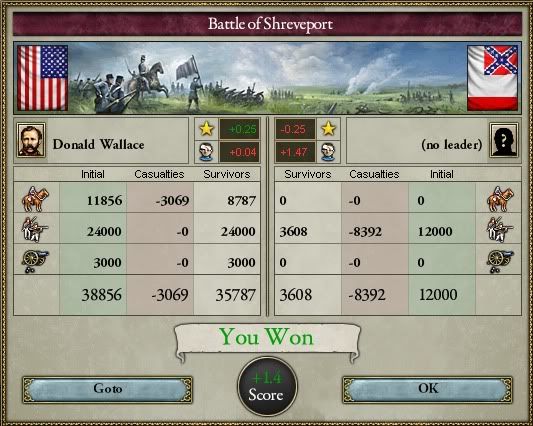
Despite early Union victories against the Confederacy, the southern troops began pushing up north into Tennessee, capturing the entire state by early April. Several skirmishes and smaller battles were fought throughout the border between Union and Confederacy, and by the second month of the war, 40,000 Americans had died on American ground. President Lincoln decided that he had to act quickly if he were to win the war and distract the Confederate soldiers from their offensive into the North. The Union was outnumbered nearly three to one, but had much better equipment and the advantage of a complete blockade of the Confederate coast, known as the Anaconda Plan.
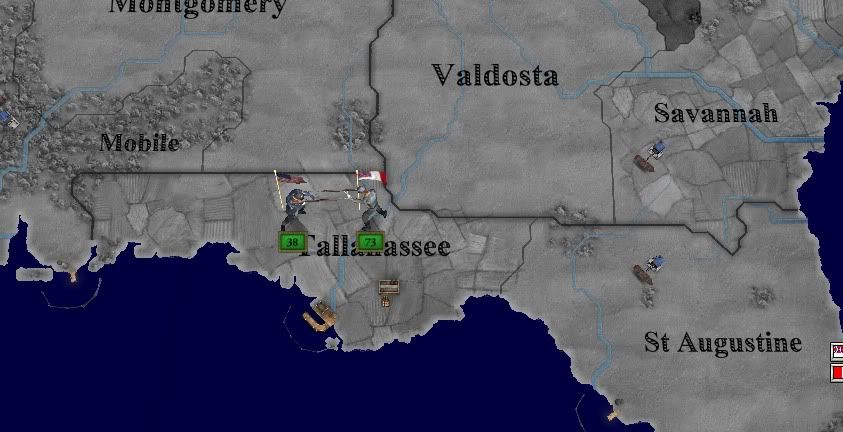
On April 18th, a Union army of 40,000 men landed in Tallahassee, Florida. Three days later they were met just off the beaches by a large Confederate force of 75,000. The resulting Battle of Tallahassee would become the most costly battle in American history, and possibly decided the fate of the War Between the States.

A House Divided
The United States thrived throughout the remainder of the 1850's. The economy was growing quickly, and had become one of the strongest in the world under the Buchanan administration. The US military also enjoyed rapid growth - especially the navy. The size of the US Atlantic fleet had tripled during the presidency of Buchanan, and was now finally able to defend the shores of America against potential blockades.
While the American navy was still no match for the British Navy, it did threaten the French and the Spanish. Tensions rose quickly between the Americans and the Franco-Spanish alliance, and in February of 1859, these tensions reached a peak when an American ship on shore leave was mysteriously destroyed. The ship, the USS Washington, was on leave on the Spanish island of Puerto Rico. President Buchanan was quick to point fingers, and within weeks the United States was once again calling for Spanish blood.

While Spain never directly took responsibility for the attacks on the USS Washington, they never denied that they were behind the attack. On July 18th, 1849, the United States demanded that the Spanish pay for the lost ship and issue a public apology. The Spanish immediately refused the demand, and three days later, on July 21st, the Second Spanish-American war began with the United States' declaration of war on Spain. France, seeing the war as a chance to cripple the US navy, decided to defend her ally and declared war on the United States the next day.

The war between the United States and the Franco-Spanish alliance went on for six months without any conflict, either on land or at sea. As January brought a new decade upon America, presidential elections began. For the first two months, James Buchanan seemed to be the dominant political figure in the United States. His only real opponent, the National Populist Party candidate, Abraham Lincoln, held some popularity in the north, but had none of the southern, pro-slavery vote.
Everything changed on March 22nd, 1860, however, when the Supreme Court made a ruling on the Dred Scott v Sandford case. The Supreme Court stated that African-Americans brought into the United States as slaves were not protected by the Constitution and could never be U.S. citizens. This shattered the north's opinion of both Buchanan and the Democratic Party. The northern states saw this as an effort to implement slavery throughout the Union, and support quickly built for Abraham Lincoln and the National Populist Party. Abraham Lincoln promised an end to the slavery debate, gaining him the vast majority of the northern vote, but costing him the southern vote. Irregardless, Abraham Lincoln was elected president with 69% of the popular vote, and the democrats were defeated for the first time in 31 years.

This stalemate between the Franco-Spanish alliance and the United States lasted until early April of 1860, when the French navy made a move to blockade the eastern US coast. In response to the blockade, the United States landed troops in major allied islands in the Caribbean. By the end of the month, Puerto Rico, Guadeloupe and Martinique were in American hands, and the US finally decided to test her new fleet.

The French blockade of the United States

US occupation of the Franco-Spanish Caribbean
The first naval battle between France and the United States began on April 29th, and lasted until May 6th. The United States' Atlantic Fleet of 35 commerce raiders launched an attack on 4 French commerce raiders. The US fleet was victorious, and quickly sailed down to the Florida Straits, where they met a larger French fleet of 8 commerce raiders. The French were once again annihilated, and the Atlantic Fleet made her way to the Lesser Antilles to face a third French fleet. Over the three battles, 12 French commerce raiders were destroyed, and the United States didn't suffer a single loss. The French blockade was broken by a superior US Navy.



France quickly gave up the naval war against the United States, and demanded an attack from her ally, Spain. The Spanish quickly drew up plans for an invasion of Haiti, with the US coast now well protected by the navy. The invasion didn't come until October of 1860, when 26,500 Spanish troops landed in Cap Haitian. The United States quickly responded by sending the 1st US Army to La Vega to cut off the Spanish advance.

On November 3rd, 1860, the two forces met. The battle was extremely one sided, with the demoralized Spanish fighting the well fed, well rested American forces. The battle lasted just a week until the Spanish army was defeated. 506 Americans died in La Vega, but the entire Spanish army was wiped out, and the Franco-Spanish alliance was defeated. The next day, on November 11th, a ceasefire was declared, and Spain ceded the remainder of her American territories to the United States.


The Americans were just as eager to make peace as the French and Spanish were, however, and there was little celebration of the victory. On January 1st, a northern abolitionist named John Brown was hanged in the state of Virginia after a failed raid on a military armory. The goal was to arm slaves to fight against the slaveholders of the south, escalating southern tension over slavery. There was open talk by southern states of secession from the Union, and the US government struggled to keep the south in line.

President Lincoln did an admirable job to appease the south, but despite his efforts, many southern states seceded over late January and early February. The US desperately attempted to hold on to these states, but on January 10th, 1861, the states formed their own government - the Confederate States of America. Tensions between north and south - Union and Confederacy - rose to a boiling point. The Union declared the secession of the south as illegal and unconstitutional, but the Confederacy stood her ground. Neither side was willing to make the first move in the Civil War, but it was the Confederacy who would begin the war by the assault on Union-held Fort Sumter on February 14, 1861.

Overall, 10 states seceded from the Union - Virginia, North Carolina, South Carolina, Louisiana, Mississippi, Alabama, Georgia, Florida and Cuba. The western half of Virginia was not willing to secede, however, and the territory of Western Virginia declined to join the Confederate States.

The first two major battles of the American Civil War occurred as the Union forces invaded the South through Louisiana and the Confederate forces invaded the North in an attempt to capture Washington. The first Battle for Washington began just 12 days after the Civil War began, and resulted in 5,000 Confederate losses. It was a decisive Union victory, and thwarted the early Confederate attempt to seize the Union capital.

With the Confederate defeat in Maryland, the Union decided to begin their own invasion, sending an army of 40,000 east from Texas into Louisiana. At the Battle of Shreveport, the Union forces met a smaller Confederate force of 12,000. The battle lasted just under a week, and on March 30th, the Confederate troops began retreating deeper into New Orleans.

Despite early Union victories against the Confederacy, the southern troops began pushing up north into Tennessee, capturing the entire state by early April. Several skirmishes and smaller battles were fought throughout the border between Union and Confederacy, and by the second month of the war, 40,000 Americans had died on American ground. President Lincoln decided that he had to act quickly if he were to win the war and distract the Confederate soldiers from their offensive into the North. The Union was outnumbered nearly three to one, but had much better equipment and the advantage of a complete blockade of the Confederate coast, known as the Anaconda Plan.

On April 18th, a Union army of 40,000 men landed in Tallahassee, Florida. Three days later they were met just off the beaches by a large Confederate force of 75,000. The resulting Battle of Tallahassee would become the most costly battle in American history, and possibly decided the fate of the War Between the States.
Well, this shouldn't take too long.
Great AAR so far. Interesting to see an expansionist US.
Great AAR so far. Interesting to see an expansionist US.
Well, this shouldn't take too long.
Great AAR so far. Interesting to see an expansionist US.
Actually it's becoming one of my longer wars. The CSA had about 250,000 troops to my ~120,000. I'm glad you're enjoying the AAR though!
How did those Civil War borders happen?
I'm not quite sure, but I'm just glad that Idaho didn't secede. The border is actually fairly nice and clean.
Actually it's becoming one of my longer wars. The CSA had about 250,000 troops to my ~120,000. I'm glad you're enjoying the AAR though!
Oh.
I'm not quite sure, but I'm just glad that Idaho didn't secede. The border is actually fairly nice and clean.
Not with Tennessee being part of the Union. Just look at that peninsula of grey jutting out of Virginia >.<
Not with Tennessee being part of the Union. Just look at that peninsula of grey jutting out of Virginia >.<
True. I'm not sure why Tennessee didn't leave, but that's okay.
Not with Tennessee being part of the Union. Just look at that peninsula of grey jutting out of Virginia >.<
Tennessee barely seceded (final secession vote was basically pushed through the legislature and many of the votes when the public voted were thrown out/ignored) and the CSA had to garrison troops in East Tennessee to keep it from doing like West Virginia and breaking away and becoming a new Union state. Wish the game could model that. A couple of the counties and that "peninsula of gray" also were 50/50 for/against secession.

